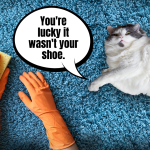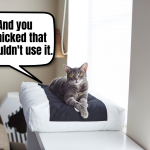Hiding is a completely normal and natural cat behaviour – who could resist a warm cardboard box, where you can hide from the curious eyes of everyone around you and doze off for a long nap! Unfortunately, running into tight corners, getting under the bed and finding the darkest nooks in the house can also be a sign of stress or an unknown illness and you shouldn’t ignore it. Shy kitties can come in all shapes and sizes, regardless of the breed, age or if the cat came from good breeders or a shelter. How can we help them and build an at-home haven for our feline seekers of tiny, under-the-bed nooks?
Why do cats like hiding?
Your cat companion might be hiding in cardboard boxes, a carrier or a wardrobe, searching for a calm and cozy place to sleep. It can be often seen with cats who live with families, where there’s always something going on and sleeping on the couch would be interrupted every five minutes. We’re not at all surprised by their desire to hide! Nobody wants to have someone washing the dishes, hoovering the floors or talking loudly and watching tv in the middle of the night in the bedroom. If your cat feels safe in their home environment, even with the noise around, he won’t be trying to hide every time – cats often stay in a safe observation spot (around hooman activity center) to be able to supurrvise their home kingdom even in the face of an upcoming nap. Things can go much different for cats who hide out of fear.
From the carers point of view, the scaredy cats might not behave differently from the confident ones, but upon closer inspection you will notice that behind every choice of their hiding spot is a will to stay invisible. New guests? Kids, who want to carry the cat in their hands like a doll? Or maybe other pets who won’t give the kitty any break? There can be many underlying reasons for a cat being wary of their surroundings, but the hiding spots will usually stay the same: dark, tight, safe and closed off, so that the cat can stay away from the danger and simply wait for it to pass.
When a cat needs some space
Cats are individualists and they need their space, which includes having some hiding spots unavailable to other members of the family. We can’t deny them access to spots where they can safely shelter themselves. However, it’s always worth it to observe our cats and make sure they’re not disappearing somewhere in the house for the whole day and stay active only during the night, when everybody else sleeps. If a cat is moving with a tail tucked under, sneaking hesitantly by people, using the litter box only when nobody’s around and choosing hiding spots where we wouldn’t even think they could hide, working with a behaviourist will be necessary.
Cat-friendly hideaways: building up your cat’s self-confidence
A corner under the bed, tight nooks in the wardrobe or a tiny space under the couch? Cats who choose those types of spaces are definitely shy and hiding not only for the sake of a long nap. As far as their safety goes, it’s not an ideal situation: what would happen, if you were looking for a cat before a vet visit, but they hid under the bed where you couldn’t reach? Or another, even more thought-provoking example: what would happen, if there was a fire inside your house and you had to take your cat as quickly as possible and leave the place? Reaching for a hiding cat against their will won’t bring any good outcomes, so the best thing is to… block them away! As cat behaviorist Jackson Galaxy says in his book, “Cat Mojo”, we should work on moving their comfort zone gradually, not blocking all the hiding spots at once, but eliminating the ones that may be the most dangerous right away. If you’ve just started working on your cat’s sense of security, before you start removing their regular (and inappropriate) hideaways, build spaces where they can feel equally as safe.
For this occasion we’re bringing our MIA cathouse to the forefront. Built with sturdy, natural corrugated cardboard and a solid structure, it provides your cat enough space to sleep comfortably while giving a sense of privacy and a chance to hide in the most stressful of times. MIA has two entries, which eliminates the risk of your cat feeling trapped if they wished to escape even this cardboard hideout. Let’s remember that even the most adventurous of cats may be looking for a cover when they hear the doorbell ring or see a stranger (a.k.a. electricity technician) entering the house. They’re just not sure if they can trust him yet!
Personalising MIA cathouse: time for DIY
To improve and personalise a MIA cathouse for a scaredy cat, we recommend starting with getting our cardboard mat fit exactly to the size of the house, keeping it sturdy and providing a good spot for scratching and a warm place to sleep. It’s also a good idea to put your cat’s blanket inside soaked with their scent (for comfort), and, for privacy, covering MIA cathouse with another blanket to block out most of the light and give some extra safety. Set by a bed, a couch or a sofa, our MIA cathouse may become a better choice for a cat used to squeezing under the furniture and sleeping uncomfortably. The way you set your MIA cathouse is important – try to put it in a place where it can actually serve as a hideout. Avoid spots where there could be danger for the cat and any high-traffic areas, where there’s always noise and movement. A nice, quiet place (without constant footsteps) providing a peaceful environment comparable to that found in the darkest corners of the house, that’s the key to a more courageous cat!
As time goes by, your kitty should get used to the household noises and stop looking for the tightest of hideaways. By that point, it would be a good idea to get another MIA cathouse, a closed-off cat bed or a cocoon in more socially significant places, e.g. your living room. It’s key to gradually convince your cat that being comfortable around people in the house is safe, while providing them with a safe place to hide at any time. It would also be a good idea to catify your house and build a cat highway: our furry friends see the environment not only horizontally, but vertically as well and if they are hiding because of the general noise and havoc around the house, there’s a high chance they will get interested in watching the space from above. The shelves shouldn’t be put so high up you can’t reach your cat in case of emergency. Cat highway also increases the chances of accomodate the house for a group of cats, but that’s a topic for another time (and we will be covering it soon).
How does building cat hideaways go in your houses, our dear fabCats? Is your living room filled with cardboard boxes that serve as a bedroom and a playground for the furries? Does your bedroom have your cats own M1? Or maybe you’re still looking for the kitty in a wardrobe every time guests come to visit? Let us know in the comments and remember: if your cat’s behaviour seems worrying, even as far as unusual hiding goes, it’s always good to consult it with a veterinarian or a behaviourist 🙂




